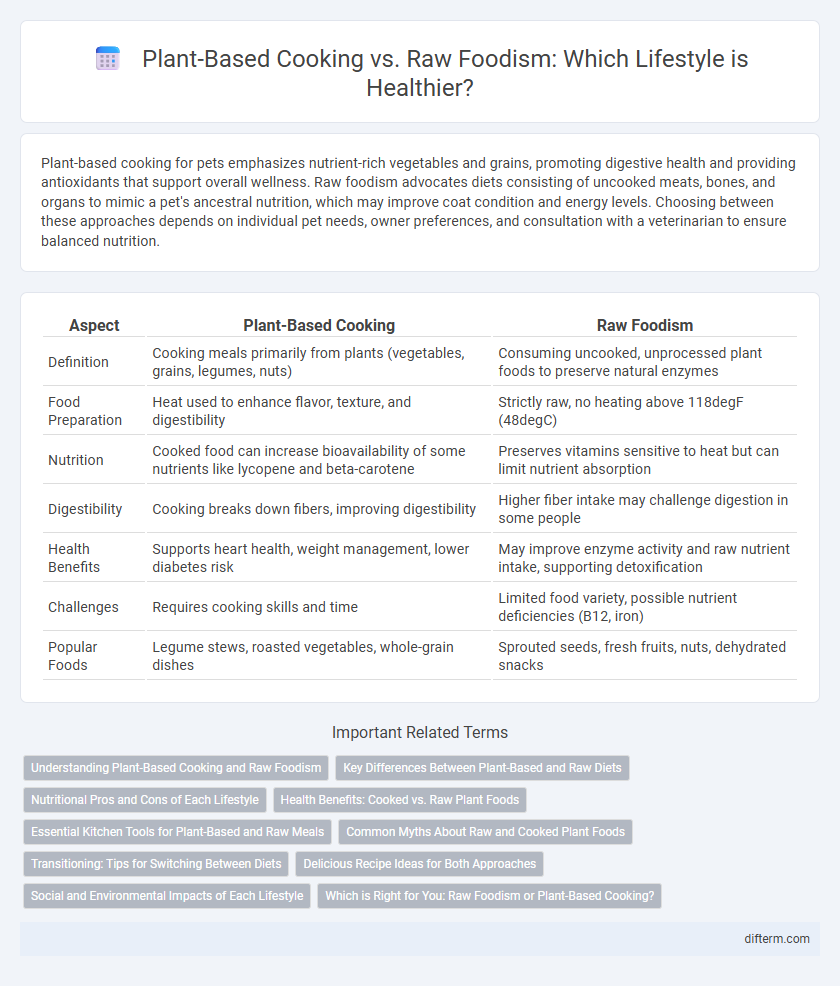Plant-based cooking for pets emphasizes nutrient-rich vegetables and grains, promoting digestive health and providing antioxidants that support overall wellness. Raw foodism advocates diets consisting of uncooked meats, bones, and organs to mimic a pet's ancestral nutrition, which may improve coat condition and energy levels. Choosing between these approaches depends on individual pet needs, owner preferences, and consultation with a veterinarian to ensure balanced nutrition.
Table of Comparison
| Aspect | Plant-Based Cooking | Raw Foodism |
|---|---|---|
| Definition | Cooking meals primarily from plants (vegetables, grains, legumes, nuts) | Consuming uncooked, unprocessed plant foods to preserve natural enzymes |
| Food Preparation | Heat used to enhance flavor, texture, and digestibility | Strictly raw, no heating above 118degF (48degC) |
| Nutrition | Cooked food can increase bioavailability of some nutrients like lycopene and beta-carotene | Preserves vitamins sensitive to heat but can limit nutrient absorption |
| Digestibility | Cooking breaks down fibers, improving digestibility | Higher fiber intake may challenge digestion in some people |
| Health Benefits | Supports heart health, weight management, lower diabetes risk | May improve enzyme activity and raw nutrient intake, supporting detoxification |
| Challenges | Requires cooking skills and time | Limited food variety, possible nutrient deficiencies (B12, iron) |
| Popular Foods | Legume stews, roasted vegetables, whole-grain dishes | Sprouted seeds, fresh fruits, nuts, dehydrated snacks |
Understanding Plant-Based Cooking and Raw Foodism
Plant-based cooking involves using whole, minimally processed ingredients such as vegetables, grains, nuts, and legumes, often incorporating heat to enhance flavors and nutrient absorption. Raw foodism emphasizes consuming uncooked, unprocessed foods to preserve natural enzymes and maximize nutrient intake, often featuring fruits, vegetables, nuts, and seeds. Both approaches promote health benefits, but plant-based cooking offers greater culinary variety and improved digestibility through cooking techniques.
Key Differences Between Plant-Based and Raw Diets
Plant-based cooking emphasizes preparing meals using whole, minimally processed vegetables, grains, legumes, nuts, and seeds with heat, which enhances flavor and nutrient absorption. Raw foodism strictly involves consuming uncooked, unprocessed, and often organic plant foods to preserve natural enzymes and nutrients that heat might degrade. The main distinction lies in the use of heat and cooking methods, influencing nutrient availability and dietary variety in plant-based versus raw food diets.
Nutritional Pros and Cons of Each Lifestyle
Plant-based cooking offers a diverse range of nutrients, including higher levels of protein, fiber, and essential fats from cooked legumes, grains, and vegetables, while enhancing nutrient absorption like lycopene and beta-carotene. Raw foodism preserves heat-sensitive vitamins such as vitamin C and certain B vitamins but may limit protein intake and reduce bioavailability of some antioxidants due to the lack of cooking. Both lifestyles require careful planning to avoid deficiencies in vitamin B12, iron, and calcium, with raw foodism necessitating more supplementation or strategic food combinations.
Health Benefits: Cooked vs. Raw Plant Foods
Cooked plant-based foods often provide enhanced nutrient availability, such as increased lycopene in tomatoes and beta-carotene in carrots, improving antioxidant intake and digestion. Raw foodism preserves heat-sensitive vitamins like vitamin C and folate, supporting immune function and skin health. Balancing cooked and raw plant foods maximizes nutrient diversity and promotes optimal overall wellness.
Essential Kitchen Tools for Plant-Based and Raw Meals
Essential kitchen tools for plant-based and raw food cooking include high-speed blenders, which efficiently create smooth sauces, nut butters, and smoothies while preserving nutrients. Spiralizers transform vegetables into noodles, facilitating creative raw dishes, and food processors enable quick chopping and pureeing to save time on meal prep. Dehydrators are vital for raw food enthusiasts, allowing them to make crackers, dried fruits, and raw snacks while maintaining the food's natural enzymes and vitamins.
Common Myths About Raw and Cooked Plant Foods
Common myths about raw and cooked plant foods include beliefs that raw diets always preserve more nutrients and that cooking destroys all vitamins. Research shows that some nutrients, like vitamin C, decrease with cooking, while others, such as lycopene and beta-carotene, become more bioavailable. Both raw and cooked plant-based foods offer unique health benefits, making variety essential for optimal nutrition.
Transitioning: Tips for Switching Between Diets
Transitioning from a raw food diet to plant-based cooking requires gradually introducing cooked vegetables and whole grains to ease digestion and maintain nutrient balance. Prioritizing nutrient-dense foods like quinoa, legumes, and leafy greens supports energy levels and overall health during the dietary shift. Staying hydrated and monitoring vitamin B12 and iron intake are essential to prevent deficiencies common in both raw foodism and plant-based diets.
Delicious Recipe Ideas for Both Approaches
Explore vibrant plant-based cooking recipes featuring roasted vegetable quinoa bowls, creamy avocado pasta, and spiced chickpea stews rich in nutrients and bold flavors. For raw foodism enthusiasts, indulge in refreshing zucchini noodles with raw marinara, kale Caesar salad with cashew dressing, and raw vegan chocolate avocado mousse providing enzyme-rich, unheated ingredients. Both approaches offer diverse, delicious options emphasizing whole foods, optimal nutrition, and satisfying taste experiences.
Social and Environmental Impacts of Each Lifestyle
Plant-based cooking significantly reduces greenhouse gas emissions by emphasizing locally sourced, seasonal ingredients that minimize transportation and energy use, fostering community-supported agriculture. Raw foodism, while promoting nutrient preservation and reduced cooking energy, can lead to higher food waste due to shorter shelf life and challenges in sourcing diverse raw produce year-round, impacting resource efficiency. Socially, plant-based cooking is more adaptable to communal meals and cultural traditions, whereas raw foodism often requires specialized knowledge and can limit social dining experiences.
Which is Right for You: Raw Foodism or Plant-Based Cooking?
Raw foodism emphasizes consuming uncooked, unprocessed fruits, vegetables, nuts, and seeds to preserve natural enzymes and nutrients, which may enhance digestion and energy levels. Plant-based cooking incorporates a variety of cooked and raw ingredients, allowing for greater culinary flexibility, nutrient availability, and incorporation of legumes, grains, and spices for balanced nutrition. Choosing between raw foodism and plant-based cooking depends on individual health goals, digestive tolerance, lifestyle preferences, and desire for dietary variety.
plant-based cooking vs raw foodism Infographic

 difterm.com
difterm.com